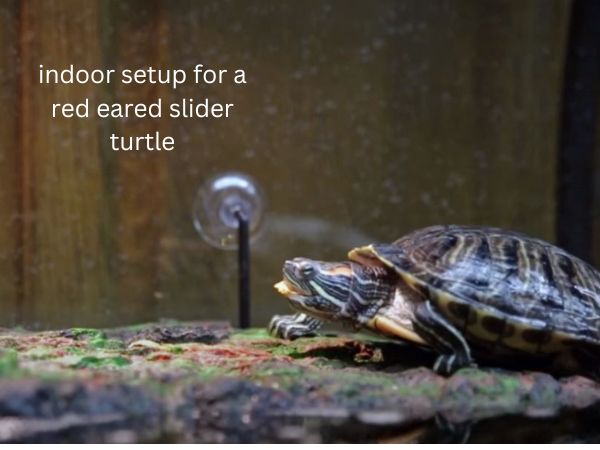Best UVB Lighting Options For Red-eared Slider Turtle Tanks
Today we discuss Red-eared Slider Turtle Tanks. Welcome to the world of red-eared slider turtle care! If you’re a proud red-eared slider turtle owner, you want to provide the best possible habitat for your aquatic friend. One of the most important factors in their well-being is the right UVB lighting. So, let’s dive in and explore the best UVB lighting options for red-eared slider turtle tanks!
UVB lighting is crucial for red-eared slider turtles because it helps them synthesize vitamin D3, which is essential for their health and proper calcium absorption. With the right UVB lighting setup, you can ensure that your turtle gets the necessary UVB rays for its overall growth and development.
Now, you might be wondering, what are the best UVB lighting options available for red-eared sliders? Don’t worry, we’ve got you covered! In this article, we’ll discuss the top UVB lighting options that provide the right amount of UVB radiation for your red-eared sliders’ tank, ensuring they thrive in a healthy environment.
So, let’s get ready to illuminate your red-eared slider’s tank with the best UVB lighting options that will make your turtle bask in happiness and enjoy a long, healthy life. Time to light up your turtle’s world!
Best UVB Lighting Options for Red-Eared Slider Turtle Tanks:
Welcome to our comprehensive guide on the best UVB lighting options for red-eared slider turtle tanks. Providing the right UVB lighting is essential for the health and well-being of your turtles. In this article, we will explore the importance of UVB lighting for red-eared sliders, discuss the different types of UVB lights available, and highlight the best options on the market.
Importance of UVB Lighting for Red-Eared Slider Turtles:
UVB lighting plays a crucial role in the life of red-eared slider turtles. These reptiles require UVB radiation to synthesize vitamin D3, which is essential for the absorption and metabolism of calcium. Without adequate exposure to UVB light, red-eared sliders can develop health issues such as metabolic bone disease, shell deformities, and a weakened immune system.
When setting up a turtle tank, it is crucial to provide a UVB light source to replicate the natural sunlight that red-eared sliders would receive in their natural habitat. This ensures that they can properly absorb and utilize calcium, helping to maintain strong shells and overall health.
UVB lighting should be provided for 10-12 hours a day, mimicking the natural day-night cycle. The intensity of the UVB light should also be appropriate for the size of your turtle tank, ensuring that the turtles receive enough UVB radiation for optimal health.
Types of UVB Lights for Red-Eared Slider Turtles:
Fluorescent Tube Lights
Fluorescent tube lights are the most common type of UVB lighting used for red-eared slider turtle tanks. They provide a broad spectrum of light, including UVB radiation, and are available in various sizes to accommodate different tank dimensions.
When selecting a fluorescent tube light, look for one specifically designed for reptiles and that emits the appropriate levels of UVB radiation. It’s also important to replace the bulbs every 6-12 months, as the UVB output diminishes over time.
One popular brand of fluorescent tube lights for turtle tanks is the Zoo Med ReptiSun Fluorescent Bulb, which provides high levels of UVB radiation and is favored by many reptile enthusiasts.
Mercury Vapor Bulbs
Mercury vapor bulbs are another option for providing UVB lighting to red-eared slider turtle tanks. These bulbs emit both UVB and UVA radiation and also produce heat, making them a multifunctional choice. They are often used in larger tanks or outdoor enclosures.
Mercury vapor bulbs are energy-efficient, long-lasting, and provide high UVB output. However, they can be more expensive than fluorescent tube lights and may require additional heating elements to regulate the temperature in the tank.
The Exo Terra Solar Glo Mercury Vapor Lamp is a popular choice among turtle owners, as it provides both UVB and UVA radiation, as well as heat, creating a natural environment for the turtles.
Compact Fluorescent Lights
Compact fluorescent lights are a more compact and energy-efficient alternative to traditional fluorescent tube lights. They are suitable for smaller turtle tanks and emit both visible light and UVB radiation.
When using compact fluorescent lights, it’s important to ensure that the turtles can get close enough to the light source to receive an adequate amount of UVB radiation. They may not be as effective for larger tanks or if the turtles spend a significant amount of time away from the light.
The Zoo Med Mini Compact Fluorescent Bulb is a popular choice for smaller turtle tanks, providing both UVB and UVA radiation in a compact size.
Tips for Choosing and Using UVB Lighting for Red-Eared Slider Turtles:
- Select a UVB light specifically designed for reptiles, with appropriate UVB output.
- Consider the size of your turtle tank and choose a light that covers the entire basking area.
- Monitor the temperature in the tank to ensure it remains within the appropriate range for red-eared sliders.
- Follow the manufacturer’s instructions for bulb replacement, as UVB output diminishes over time.
- Ensure the UVB light is positioned at the right distance from the basking area, allowing turtles to receive optimal UVB radiation.
Best UVB Lighting Accessories for Red-Eared Slider Turtle Tanks:
1. Basking Platforms:
Basking platforms are essential for red-eared slider turtles, as they provide a dry area for them to rest, bask, and absorb UVB radiation. Look for basking platforms that are sturdy, easy to clean, and large enough to accommodate your turtles comfortably.
The Zoo Med Turtle Dock is a popular choice among turtle owners, as it can be adjusted to different water levels and provides a secure and spacious basking area.
2. Timer Controls:
Timer controls allow you to automate the lighting schedule in your turtle tank, ensuring consistent and appropriate exposure to UVB radiation. Set the timers to turn the lights on and off at the desired times, mimicking the natural day-night cycle for your turtles.
The Century Indoor Mechanical Timer is a reliable and easy-to-use option for regulating the lighting schedule in your turtle tank.
3. Heat Lamps:
Heat lamps can be used in conjunction with UVB lighting to provide additional warmth in specific areas of the tank. Red-eared slider turtles require a basking spot with a higher temperature, and a heat lamp can create the ideal basking area for them.
The Fluker’s Red Heat Bulb is a popular choice for providing supplemental heat to turtle tanks, ensuring that the basking area is at the right temperature.
In summary, choosing the best UVB lighting options for red-eared slider turtle tanks is crucial for their overall health and well-being. Fluorescent tube lights, mercury vapor bulbs, and compact fluorescent lights are the most popular choices, each with its own advantages. Consider the size of your tank, the UVB output, and the needs of your turtles when selecting UVB lighting. Remember to provide essential accessories like basking platforms, timer controls, and heat lamps to create a comfortable and stimulating environment for your red-eared sliders.
Key Takeaways: Best UVB Lighting Options for Red-Eared Slider Turtle Tanks
- UVB lighting is essential for red-eared slider turtles to maintain good health.
- A UVB bulb with a rating of 5% to 10% is recommended for optimal UVB exposure.
- Compact fluorescent bulbs or mercury vapor bulbs are popular choices for UVB lighting.
- Position the UVB light at a proper distance to provide enough UVB rays without causing harm.
- Regularly check and replace the UVB bulb to ensure consistent UVB output.
Faqs for Red-eared Slider Turtle Tanks:
UVB lighting is crucial for red-eared slider turtles as it helps them metabolize calcium and vitamin D3. Without UVB exposure, turtles can suffer from metabolic bone disease, which can lead to deformities and even death. UVB lighting also promotes good shells and overall health.
In the wild, red-eared slider turtles bask in the sun, soaking up UVB rays. In captivity, replicating their natural environment with UVB lighting is essential for their well-being.
There are two main types of UVB lighting options for red-eared slider turtle tanks: fluorescent UVB bulbs and mercury vapor UVB bulbs.
Fluorescent UVB bulbs are cost-effective and widely available. They provide sufficient UVB radiation for turtles but need to be replaced every 6-12 months to maintain their effectiveness.
Mercury vapor UVB bulbs, on the other hand, emit more intense UVB rays and also provide heat. They are more expensive but can last up to 12-18 months with regular use.
The recommended distance for UVB lights from the turtle tank depends on the specific bulb and wattage. Generally, it’s best to follow the manufacturer’s instructions. In most cases, placing the light around 12-18 inches above the basking area is ideal.
It’s important to ensure that the UVB light is unobstructed by any barriers, such as mesh screens or glass lids, as these can reduce the effectiveness of UVB radiation reaching the turtle.
Red-eared slider turtles should have access to UVB lighting for about 12-14 hours per day. This mimics the natural sunlight they would receive in the wild and allows for proper calcium metabolism and vitamin D3 synthesis.
Using timers is a convenient way to ensure the UVB light is consistently available for the recommended duration and helps to establish a day and night cycle for the turtle.
While natural sunlight can provide excellent UVB radiation for red-eared slider turtles, relying solely on it can be challenging and may lead to inconsistent exposure. Factors such as weather conditions and seasonal changes can affect the availability of natural sunlight.
While natural sunlight can provide excellent UVB radiation for red-eared slider turtles, relying solely on it can be challenging and may lead to inconsistent exposure. Factors such as weather conditions and seasonal changes can affect the availability of natural sunlight.
Therefore, using UVB lighting alongside natural sunlight or as a primary light source in captivity is recommended to ensure turtles receive adequate UVB rays consistently.
Summary
UVB lighting is really important for red-eared slider turtles because it helps them stay healthy. There are two popular options: mercury vapor bulbs and linear fluorescent bulbs. Mercury vapor bulbs are bright and give off more UVB, but they can be hot and expensive. Linear fluorescent bulbs are cheaper and produce less heat, but they may not give off enough UVB. It’s important to choose the right bulb for your turtle’s tank size and monitor the temperature regularly to keep your friend happy and healthy.




